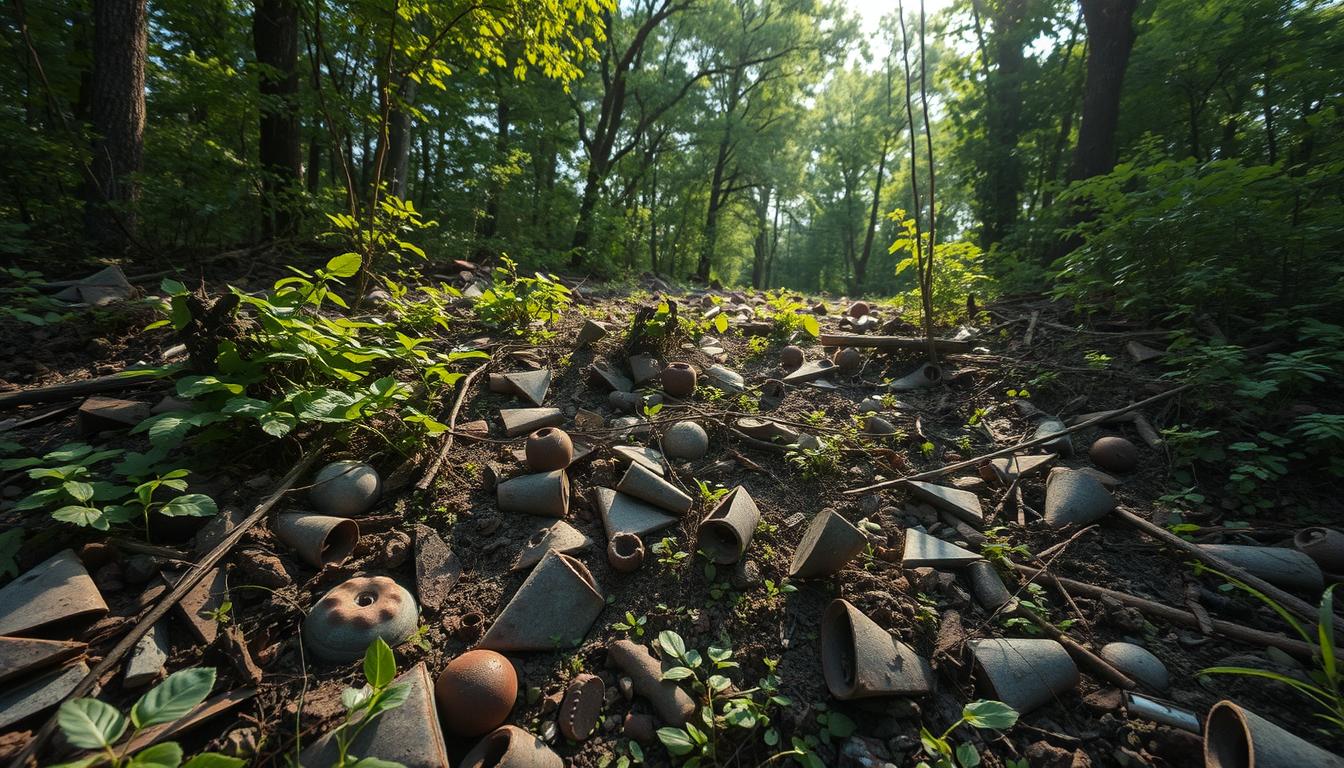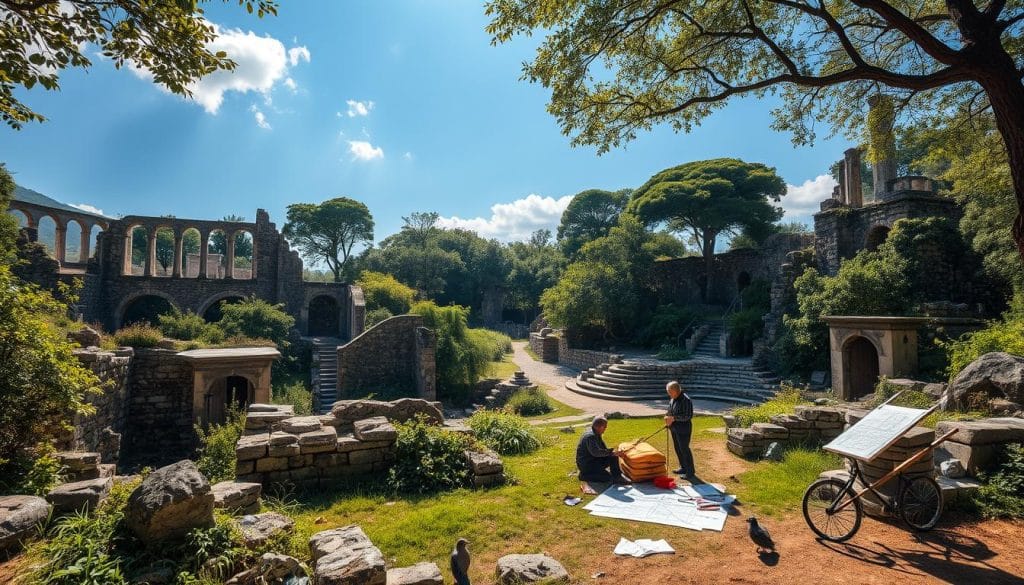Did you know about 1,100 square miles of land in Iraq are covered with explosive remains1? This includes pieces from old wars. This big number shows how wars affect places and people even after they end. Like Iraq, Europe’s old battlefields, especially from World War I, are also marked by bunkers, trenches, and many war relics.
In France and Belgium’s fields, finding old shrapnel is common. It’s a silent witness to the Great War’s sacrifices and stories. Every bit of shrapnel found connects us to history. It shows the tough times soldiers faced a hundred years ago.
The study of old warzones is key to keeping these relics’ stories alive. From the Western Front’s trenches to Verdun’s fields, shrapnel shows us history. It honors those who fought by remembering them.
Key Takeaways
- Around 1,100 square miles of land in Iraq are still contaminated with explosive remnants, including legacy shrapnel1.
- Historical shrapnel from World War I continues to surface in European battlefields, creating a link to the past.
- Modern conflict archaeology helps preserve wartime relics and provides crucial historical insights.
- Shrapnel fragments from past wars serve as poignant reminders of the sacrifices made by soldiers.
- Volunteers and researchers work tirelessly to uncover and interpret these remnants of conflict.
- Wartime relics play a significant role in historical remembrance and cultural heritage.
- Efforts to clear contaminated lands are ongoing, with significant challenges still ahead.
The Impact of World War I on Modern Conflict Archaeology
Modern conflict archaeology is a new field. It aims to uncover stories hidden in old battle sites. By studying relics from the past, we learn more about wars and their effects today. Leaders in this field, like Professor Nicholas J Saunders, mix different studies to look at war’s complex legacies.
Introduction to Modern Conflict Archaeology
This field takes a close look at World War I through its remaining pieces. It explores large battle sites and small items, like pieces of shrapnel. This helps tell a fuller, more human story of what happened.
Case Study: The Western Front Trenches
The Western Front is a key focus in this research. Experts study the objects soldiers left behind to learn about their lives. They look at the trenches to understand the soldiers’ struggles and perseverance. This area has revealed many objects, from personal belongings to pieces of shrapnel. These findings give us a clear picture of the soldiers’ experiences.
Shrapnel and its Material Legacy
Shrapnel from World War I tells us a lot about the war. These metal pieces, found on old battlefields, help archaeologists figure out what happened in battles. From the battlefields of Rawka and Bzura, where over 20,000 artifacts were studied, to the German army’s use of chemical weapons, these studies show the harsh reality of war23. By examining shrapnel, researchers learn about the chaos and strategies of historical battles.
Looking at these artifacts shows the war’s terrible effects and the progress in weapon technology. Understanding shrapnel’s history helps us grasp the full impact of World War I. It reminds us of this dramatic event’s lasting influence.
Legacy Shrapnel: Remnants of the Great War
Preserving World War I shrapnel helps connect us to our past. It shines a light on what people went through during the war. Efforts to keep these pieces safe honor the soldiers’ bravery and sacrifice.
Modern Legacy Shrapnel Preservation Efforts
Recently, there’s been more focus on keeping historical shrapnel safe. Volunteers and historians have poured their energy into places like Main de Massiges and Verdun’s Bois Azoule Forest. Their hard work keeps history alive for all of us.
The Main de Massiges is a key World War I site turned museum. Here, volunteers work hard to keep the trench lines and relics from disappearing. Their efforts showcase the tough conditions soldiers endured and their unbreakable spirit.
Volunteers at Main de Massiges
Main de Massiges stands as a tribute to World War I soldiers’ courage. Since 2008, dedicated volunteers have spent countless hours preserving trenches and artifacts. This work creates a bridge to the past4.
Their commitment has transformed a once devastated battlefield into a museum open to all. This ensures the bravery and sacrifices of those soldiers are always remembered.
Artifacts from Verdun’s Bois Azoule Forest
The Bois Azoule Forest near Verdun holds vital World War I history. Historians and volunteers keep finding important items there4. These discoveries provide a glimpse into soldiers’ lives and the strategies used in the war.
The effort to preserve Verdun’s history helps us grasp the war’s enormity and its profound effects. Such dedication to preservation teaches us about the sacrifice and resilience of those who faced the war’s horrors.
The Role of Shrapnel in Historical Remembrance
Shrapnel artifacts play a key role in remembering history. They remind us of wars and deeply mark the places they’re found. By understanding these artifacts, communities connect with their history, creating a shared identity.
Sites of Memory
Sites of memory are very important. They turn old battlefields into places for thinking and learning. For example, shrapnel pieces at Arbroath Abbey, set up in 1178, are now historical markers5.
Such places become sacred, mixing stories and artifacts. They keep the memory of wars alive for future people.
These relics have a complex story. Parts of the abbey were used in 1580 to build a new church. This shows how heritage is reshaped over time5. Sites like these create a real link to history, making abstract tales concrete.
The Cultural Heritage of Shrapnel
Shrapnel holds a special spot in our cultural heritage. These pieces, from violent times, remind us of terror and bravery. A book titled “Shrapnel—Tales of a Soldier Dad” shows veteran stories6. It highlights the role of these pieces in remembering personal and public histories.
Shrapnel has also helped shape community identities. After World War I, some children were named Verdun or Dorrien. This shows how deep these events are in our society7. Shrapnel, as a symbol of our shared history, makes us think about past conflicts’ effects on us today.
Shrapnel Remnants Across Europe
In France and Belgium, hidden munitions and the reconstructed Wire of Death tell a story. They merge into Europe’s landscapes, rural and urban alike. These pieces show history’s scars and remind us of Europe’s stormy past during wars.
On June 6, 1944, a massive force of over 160,000 Allied troops landed on Normandy’s shores. They aimed to take Omaha Beach, facing 7,800 German soldiers. The beach’s sand is a silent witness, with about 4 percent of it being shrapnel.
This shrapnel, tiny yet telling, ranges from 0.06 to 1.0 millimeters. It hints at the fierce battle that raged here, with traces like calcium and magnesium on glass beads. These elements suggest the high temperatures of explosions during the assault, reaching up to 1200 degrees Celsius.
Europe’s battlefields have left a deep mark on its history. Overlooking Omaha Beach, the American cemetery honors more than 9,000 soldiers. It’s a place of remembering the pain and teaching future generations about war’s cost and trauma.
In different parts of Europe, efforts are made to keep the history of the Western Front alive. These spots are not only historical but also serve as places to learn about war’s impact. They remind us of today’s global challenges, like the pandemic that affected millions.
By protecting these sites and the shrapnel scattered across battlefields, a story of endurance and learning unfolds. Cities and regions touched by war are reshaping. They honor their past, sharing powerful lessons of survival with the next generations.
| Location | Significance | Statistics |
|---|---|---|
| Omaha Beach, France | Site of D-Day landings | 160,000 Allied troops, 34,250 captured beach, 7,800 German troops, 9,000 casualties8 |
| Western Front, Belgium | Historical preservation | Includes Verdun and Main de Massiges efforts |
| Normandy, France | American cemetery | 9,000 servicemen buried, surviving veterans in late nineties9 |
Shrapnel Collectibles: From Battlefield to Museum
Shrapnel collectibles are a way to connect the past to today. They include things like bits of artillery and bullet cases. These items are popular in both private collections and museums. They give us a closer look at what soldiers went through and how wars affect the world.
Private Collections and Public Exhibitions
In places like Novgorodskoe, in the Donbass region, nearly every home has shrapnel and bullet cases10. This shows how deeply conflict affects communities. Meanwhile, the Queensland Museum showcases over seventy items from the First World War11. These artifacts give us insight into the war and are shared with the public.
The Queensland Museum’s collection has helped create a public database11. This database is used to teach people about the history of war through social media and blog posts.
The Ethics of Shrapnel Collection
Collecting shrapnel raises ethical questions. These artifacts provide important historical perspectives and personal connections. Yet, they also prompt discussions about the ethics of collecting. It’s a balance between remembering history and the risk of exploitation.
The Queensland Museum shows the value of responsible collecting with their formal donations received from 1917 to 198611. Both private collectors and museums must carefully respect history without commercializing it.
We must understand these issues to respect and honor the history of wars. This ensures collections of shrapnel and wartime relics are handled with care. It helps us appreciate the sacrifices made and learn from past conflicts.
The Evolution of Wartime Relics
Wartime relics have changed a lot over time. They went from reminders of dark times to valuable tourist attractions and places where we can learn. For example, Fort Douaumont tells many stories of bravery and is full of history.
Transition from Battlefield to Tourist Attraction
Fort Douaumont used to be a place of fierce fights. Now, it’s a place that reminds us of history and draws in many visitors each year. These old battle sites teach us something, by giving us an up-close look at history.
The Historical Significance of Fort Douaumont
Fort Douaumont played a big role in World War I. Today, it is well-kept and lets us see history as it was. It’s a favorite spot for those who love history. Turning these sites into spots people can visit respects our history and helps local areas make money.
Premier Relics even helps veterans by giving a part of their earnings from selling artifacts to charities. They donate 5% of total sales to groups like Operation Homefront and Operation Gratitude12.
Hidden Histories: Shrapnel in Urban Landscapes
While upgrading cityscapes, we often discover relics from the past. Shrapnel, found during these times, points to our cities’ hidden histories. These pieces tell us about long-gone battles right beneath our feet.
In the Netherlands, study shows the importance of data in shaping cities. This country competes with bigger European nations thanks to its smart architecture. It uses data and follows rules, leading to innovative buildings that stand out13.
Finding old war fragments in cities links today with the war times. Nick Stone explores this theme in his display, ‘Vanishing Points’, showcasing relics from France and Flanders14. His work connects urban renewals in places like Coventry with their war-torn past14.
Stone shows how cities keep history’s secrets. Drawing from artists and photographers, his projects uncover stories hidden in urban settings14. Every city corner could be holding pieces of history, waiting to be found.
In the Netherlands, revamping cities focuses on making them denser and more complex13. As cities change, they reveal new stories about their past, shedding light on old conflicts.
In essence, uncovering old war pieces in city upgrades reminds us of war’s impact. Combining architectural methods with these historical finds enriches our understanding of history within our urban environments.
Conflict’s Legacy: The Stories Behind Shrapnel Artifacts
War leftovers often remind us of conflict’s long-lasting effects, turning simple things into powerful symbols. Shrapnel artifacts stand out, bearing personal and displacement stories. These items, collected for exhibitions, show the deep human cost of war.
Personal Accounts of Displacement and Remembrance
Stories like Ahmed al-Sabah’s add understanding to shrapnel artifacts. These tales transform inanimate objects into symbols of survival and memory. Ahmed’s displacement story underscores conflict’s lasting effects on human lives.
During World War I, art from shell casings and bullets emerged. Later, in WWII, artists used aircraft parts and enemy weapons. These art pieces symbolize resilience, change, and rebirth (more details)15.
The Continuous Displacement in Kafranbel
Kafranbel shows the ongoing displacement from conflict. Its people face repeated upheavals, creating a shared narrative of survival. Kafranbel’s tale, tied to shrapnel artifacts, highlights hard-won human resilience.
Shrapnel, also called Sharpshot, led the Insecticons in Demon Swamp. He was later found by Megatron’s Decepticons. This story signifies the adaptability and endurance through long upheavals (read more)16.
The Significance of Antique Shrapnel in Cultural Studies
Antique shrapnel sheds light on cultural studies, especially in conflict archaeology. These pieces from old battles help us understand how war impacted ethnic identity and social relationships. Researchers are now looking more at wars through the things left behind17. Viewing conflicts this way gives a deeper insight into cultural identity tied to these artifacts.
Modern Conflict Archaeology Perspectives
Today’s conflict archaeology looks beyond military aspects. It explores the material culture from wars18. Studying items from bullets to tanks teaches us about their historical and cultural significance. This method combines history, anthropology, and archaeology for a fuller picture of how war relics connect people and objects18.
Ethnicity and Identity in Conflict Archaeology
Antique shrapnel research explores conflict’s effect on ethnic identity. These pieces symbolize trauma, resilience, and culture, providing a concrete connection to the past. Merging conflict archaeology with cultural studies opens up ways to study social dynamics and the impact of war relics18. This teamwork across disciplines helps us see the deep ties between material culture and identity in times of war.
From the Iron Harvest to Wartime Memorabilia
In West Flanders, Belgium, a phenomenon known as the Iron Harvest uncovers World War I artifacts yearly. These finds include unexploded ordnance and important wartime keepsakes. They remind us of the conflict’s vast scale.
Annual Discoveries in West Flanders
The Iron Harvest marks World War I’s lasting impact. French and Belgian farmers find shells, shrapnel, and bullets in their fields every year. The Zone Rouge, heavily contaminated by war, kills 99% of its plants because of the polluted soil19. Despite efforts, clearing all munitions might take centuries19.
Shrapnel as Evidence of Conflict’s Scale
Shrapnel found during the Iron Harvest shows how massive the battles were. The Battle of Verdun alone left a vast amount of war debris19. Shrapnel pieces connect us to the intense struggles and losses of the Great War. About 9 million soldiers died, highlighting the immense human cost20.
- The World War I armistice began on the 11th hour of the 11th day of the 11th month in 191820
- Ninety-nine percent of plants in the Zone Rouge die due to the soil’s contamination with arsenic19
- Neutralizing unexploded ordnance from the World Wars is estimated to take several centuries21
The Iron Harvest does more than uncover relics; it brings war stories to life. It turns history’s echoes into solid evidence of past battles.
Shrapnel Artifacts and Their Place in Contemporary Memory
Shrapnel pieces link us to history, showing the tough realities of war. Museums and memorials help keep this history alive. They do so by showing these relics and teaching us about them.
The Role of Museums and Memorials
Museums and memorials connect us with shrapnel’s history. They offer a space to learn from war’s raw stories. This ensures we remember the lessons war teaches us.
For instance, the Imperial War Museum in London has a vast collection of shrapnel. These pieces tell us about war’s vastness and effects. Through these, we learn about warfare’s complexities22.
Public Perception and Education
How we see these artifacts is influenced by their display. Interactive setups and stories help us understand history better. Programs like tours and workshops stress the importance of remembering our shared histories.
Graphic novels and games also play a role. They make learning about history more engaging23. These methods provide new ways to see and understand our past23.
Preservation Efforts and Challenges
Keeping old war remnants and related items safe is tough. It’s filled with problems and hard choices. Experts work hard to protect history, while making sure it fits in with our stories of the past.
In places hit by recent wars, saving history has gotten more urgent. For instance, important spots in Syria like the Krak des Chevaliers fortress have been damaged in the Syrian war24. In Mali in 2012, UNESCO World Heritage Sites were harmed by armed groups24. These incidents have made people worldwide pay more attention to protecting cultural heritage.
Groups like CCHAG and IMCuRWG work to keep cultural sites safe24. They aim to avoid bad outcomes, like being criticized internationally24.
Even with strong efforts to protect them, historical items are fragile. A digging project in Normandy in 2018 found teeth, bones, plane parts, and many bullets in a small area25. This shows the careful work needed to handle these items right.
The CCHAG and U.S. Africa Command are making big moves to save historical items24. Their work shows the difficult balance between respecting artifacts and the duty to protect them. Saving these pieces of history is complex and challenging.
Protecting our cultural treasures often needs many countries to work together. Putting money into better ways to keep items safe and focusing on teamwork across fields can help us save important artifacts. Doing so is our shared promise to honor our history, even when it’s tough.
The Stories Shrapnel Tells: Personal Narratives of War
Ahmed al-Sabah’s story shines brightly among many. It shows the power of the human spirit against displacement. His experiences go beyond mere battle tales. They show how wars deeply affect people and their families.
Ahmed al-Sabah’s Displacement Experiences
Leaving a place is more than just a move for Ahmed al-Sabah. It meant losing his home, community, and even his sense of self. Violence in his homeland forced him to flee many times. Each escape added to his story of struggle and resilience.
Ahmed’s story helps us understand the larger impact of war. It echoes the losses of the Battle of the Meuse Argonne in 1918. There, thousands of American soldiers died or were injured26. Like those soldiers, Ahmed carries the marks of war, both inside and out.
Ahmed’s story also shows the power of remembering through personal items. These pieces of the past, like war shrapnel, link him to his experiences. They reveal the loss, courage, and change that come with war. His story offers a rich insight into the trials of the human spirit amid conflict.
Reflecting on Ahmed al-Sabah’s journey reminds us of the importance of these personal stories. They are part of our shared history, teaching us about the human side of war and displacement.
Conclusion
Exploring legacy shrapnel connects us to our complicated history. It mixes history, archaeology, and personal stories. This journey through memories of shrapnel across Europe shows us the importance of preserving these sites. Thinking about these pieces helps us learn more about history and understand the deep effects of conflict.
Artifacts, like those in Verdun’s Bois Azoule Forest, and stories, such as those of Ahmed al-Sabah, are important markers. They show the strength and determination of those touched by war. Every shrapnel piece tells a story, from the Western Front’s trenches to the hidden tales in cities.
The huge loss on Omaha Beach, where over 9,000 Allied soldiers died, is remembered. So are the efforts of volunteers today at Main de Massiges. These stories stress why it’s vital to keep remembering and understanding legacy shrapnel27. When we hear these tales, we should think about how history influences our present and future. We see shrapnel not just as war remnants but as meaningful symbols of memory and learning.









